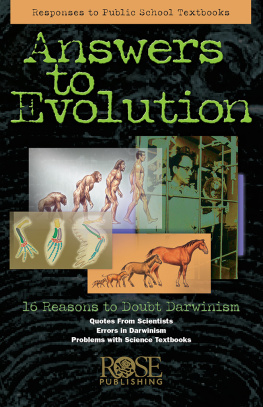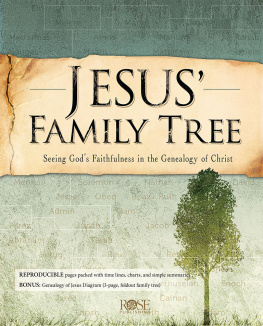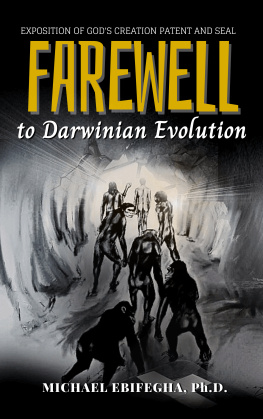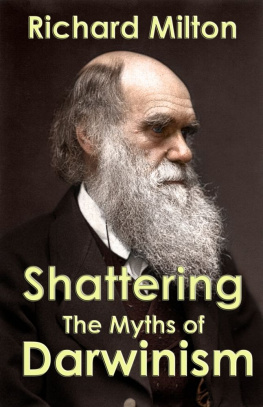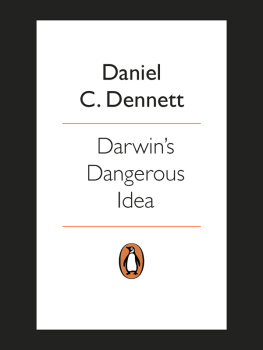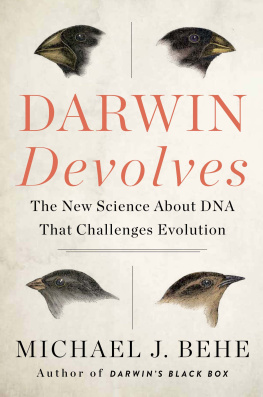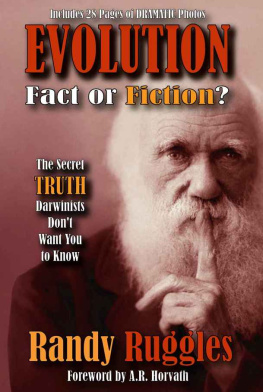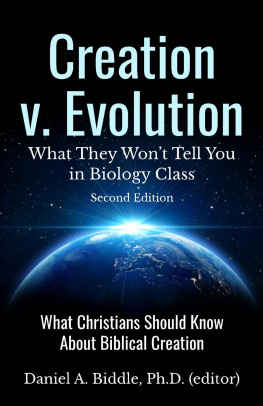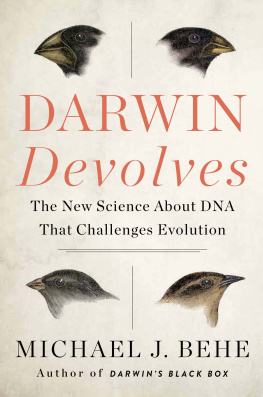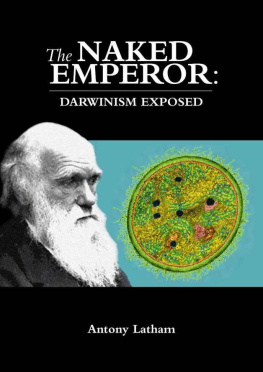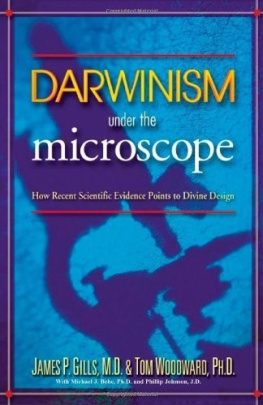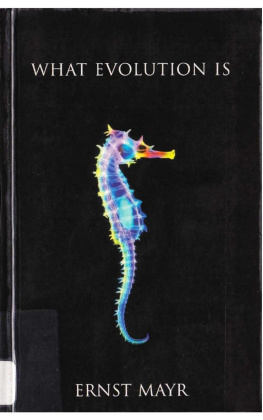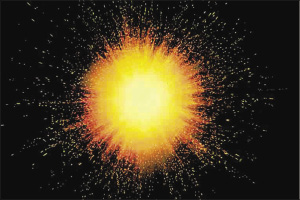The printed version of this eBook is the Answers to Evolution pamphlet, ISBN-13: 9781890947897
Special Thanks to those who made constructive criticisms and suggestions for revisions and clarifications. Any errors of fact or interpretation are not theirs but our own. We are grateful to the following:
Fazale Rana, Ph.D., Vice President for Science Apologetics, Reasons to Believe.
John L. Wiester (MA, Stanford), instructor in biology and author of The Genesis Connection and Whats Darwin Got to Do with It? .
Illustrations: Robert Greisen
It is illegal to photocopy, transmit electronically, post on the internet, or reproduce this pamphlet in whole or in part in any form.
2004 RW Research, Inc.
Rose Publishing, LLC
PO Box 3473
Peabody, Massachusetts 01961-3473 U.S.A.
Email: info@hendricksonrose.com
www.hendricksonrose.com
All rights reserved.
Build: 2022-05-17 16:19:47 EPUB 2.0
Answers to Evolution
This handy eBook:
- Tackles 16 key questions regarding the theory of evolution and provides reliable insight on the gaps, flaws, and holes in the theory in less than 30 minutes.
- Answers questions, such as: s Darwin's theory of evolution a fact? Does the fossil record support Darwin's theory? and What is the Big Bang Theory?
- Offers clear and easy-to-understand explanations on topics such as: selective breeding; microevolution vs. macroevolution; punctuated equilibrium; and more.
- Gives students dozens of quotes from respected scientists to help refute the evolutionary theory, pointing out that even Darwin believed it could be flawed.
Darwins Observations
Most textbooks teach about a great naturalist named Charles Darwin who developed the theory of evolution by observing animals in the early 19th century. Darwins theory suggested that complex creatures evolve from simple ancestors that gradually adapt to a changing environment over time.
Q1 Is Darwins Theory of Evolution a fact?
No, the theory of Darwinian Evolution says that complex creatures evolve from simple creatures naturally over time. This theory is not a fact; it has not been proven and cannot be replicated in a laboratory. A scientific theory is an attempt to make accurate statements about factual evidence in the natural world. There are several theories that attempt to explain how complex animals came to exist.
The key to good scientific reasoning begins with gathering as much reliable evidence as possible and looking at it carefully. Then, scientists construct alternative theories and compare them in light of how well they explain the evidence. As a result of this, Darwins theory has undergone many changes over the years to conform to the evidence. However, many unresolved scientific issues remain.
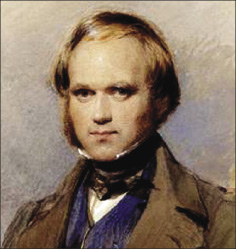
CHARLES DARWIN
Q2 Is there any proof that evolution happened?
That depends on what you mean by evolution. The term evolution basically means change, and is too broad to be very useful in a discussion. Here are four ways the word evolution is used:
- Microevolution (small changes in a population over time, such as the color of moths or the size of a birds beak).
- Macroevolution (the random development of new structures like wings, new organs like lungs, and new body plans)
- Universal Common Descent (organisms descending from a common ancestor)
- Natural Selection (survival of species, survival of the fittest)
Darwins followers say that life forms became more and more complex through a gradual process. However, some scientists have given up on that notion of gradual change. They insist that there simply is not enough time since the beginning of the universe for all the required changes to have taken place gradually. Darwins theory of evolution does not account for the beginning of life on earth.
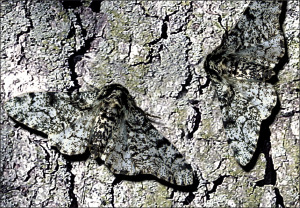
The peppered moths color changes illustrate microevolution, not Darwins theory of macro evolution.
Beginnings, Origin of Life
Many science textbooks teach that the universe began with an explosion 14 billion years ago. Darwins theory suggests that complex creatures such as human beings developed from single-celled animals over 5 billion years. Mathematicians say that life could not become that complex that quicklyeven in 100 billion years.
Q3 What is the Big Bang Theory?
The Big Bang theory says that the entire universe began as a super-hot, super massive explosive point, and that the universe continues to expand.
The first chapter of Genesis says that God created the universe out of nothing. The Big Bang theory also says the universe was created out of nothing.
If the universe was created the way the Big Bang theory says it was, we should see stars and galaxies moving away from each other (and away from us). We should also be able to detect cosmic background radiation from the Big Bangs fiery explosion. Both of these phenomena have, in fact, been observed as the theory predicts.
Q4 Is the Big Bang Theory good news or bad news for the theory of evolution?
The Big Bang theory is bad news for the theory of evolution. Why? Darwins theory requires extremely large amounts of time to produce the necessary changes in living forms. However, the Big Bang theory says that there was a beginning, a point in time when the universe was created, and that point was not long agonot long enough for any organism to evolve. According to most mathematical calculations, a universe even 100 billion years old is not old enough for the development of a single cell.
The Big Bang theory appears to be consistent with the biblical account of creation in Genesis, which says that God created the world out of nothing.
Some scientists dislike the Big Bang idea precisely because it sounds too much like biblical Creation.
In the 1920s, Albert Einstein
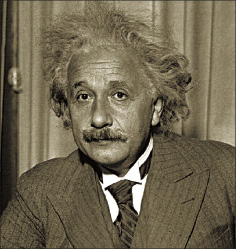
ALBERT EINSTEIN
The current scenario of the origin of life is about as likely as the assemblage of a [Boeing] 747 by a tornado whirling through a junkyard. Sir Fredrick Hoyle
Q5 Can molecules of non-living matter be transformed by a natural process into the organic building blocks of life (proteins)?
It is virtually impossible to produce important life molecules, such as proteins, from simple molecules. Proteins in all living things are assembled from the same basic alphabet of 20 amino acids. Each different type of protein is formed from a unique arrangement of these chemical letters. To form a protein that actually works, the amino acid letters must be arranged in precise sequences, like letters in a sentence. This precise sequence creates a certain protein that has a specific function in the cell. The odds that all of these factors will occur on their own is statistically impossible.

